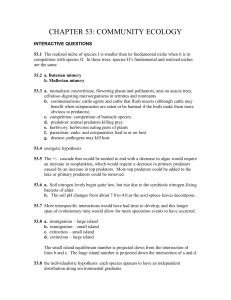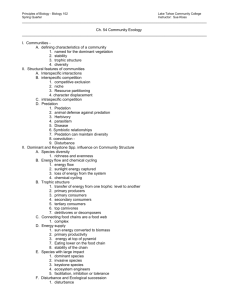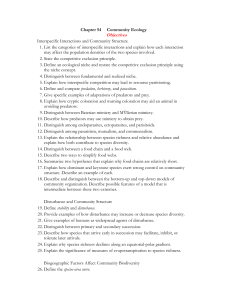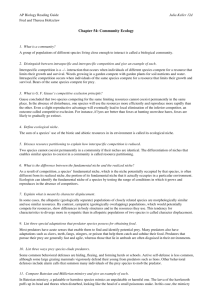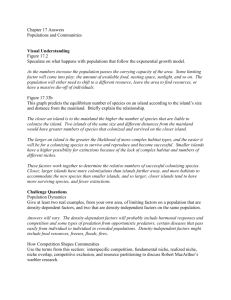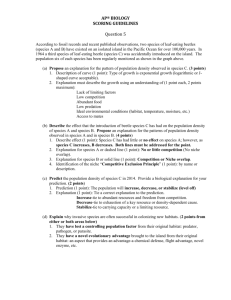Chapter 54 Community Ecology Name: 54.1 Community interactions
advertisement
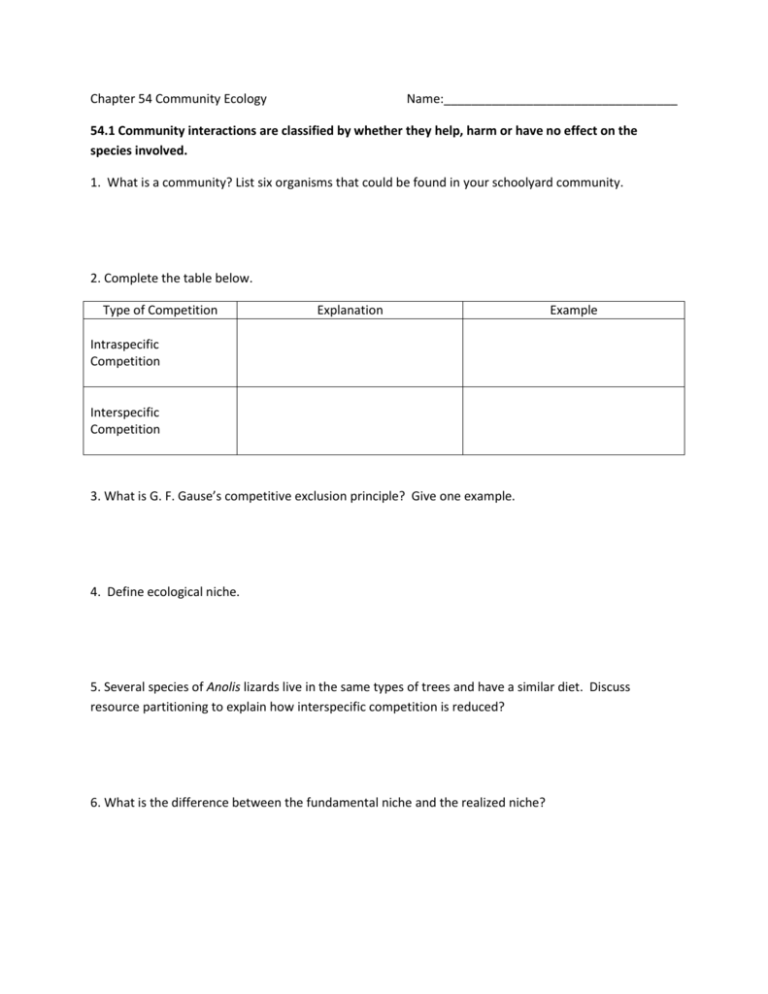
Chapter 54 Community Ecology Name:__________________________________ 54.1 Community interactions are classified by whether they help, harm or have no effect on the species involved. 1. What is a community? List six organisms that could be found in your schoolyard community. 2. Complete the table below. Type of Competition Explanation Example Intraspecific Competition Interspecific Competition 3. What is G. F. Gause’s competitive exclusion principle? Give one example. 4. Define ecological niche. 5. Several species of Anolis lizards live in the same types of trees and have a similar diet. Discuss resource partitioning to explain how interspecific competition is reduced? 6. What is the difference between the fundamental niche and the realized niche? 7. Study figure 54.4 and then explain what is meant by character displacement. 8. Predation is a term you already know. Can you give some examples of some predator-prey combinations as listed below? Predator Animal Animal Fungus Bacteria Fungus Prey Animal Plant Animal Animal Plant Example 9. List three special adaptations that predator species possess for obtaining food. 10. List three ways species elude predators. 11. Compare the two types of mimimcry. Type of Mimicry Batesian Mullerian Description Example 12. What is herbivory? 13. List two special herbivore adaptations for predation and two plant adaptations to avoid herbivory. 14. Describe and give an example of each of the following interactions: Type of Interaction Description Symbiosis Parasitism Mutualism Commensalism 15. Which category above includes the other three? Example 16. Your text uses +/-/0 symbols to indicate how interspecific interactions affect survival and reproduction of the two species. Use this notation for each of these interactions. Type of Interaction +/+, +/-, -/-, +/0 Predation Commensalism Mutualism Parasitism Interspecific competition Herbivory 54.2 Diversity and trophic structure characterize biological communities 17. What is species diversity? What are its two components? Why is it so important? 18. What does an ecologist summarize in a food web? 19. Know the levels of trophic structure in food chains. Give a good chain here, including four links that might be found in a prairie community, and tell the level for each organism. 20. Name every organism in the picture food chain (page 1202) and give the trophic level in the box. 21. According to the energetic hypothesis, why are food chains limited in length> How much energy is typically transferred to each higher level? 22. What is a dominant species? For the area where you live, what would be considered a dominant tree species? 23. How is a keystone species different from a dominant species? 24. Name one keystone species, and explain the effect of its removal has on the ecosystem. 25. Explain facilitator or foundation species and give an example. 54.3 Disturbance influences species diversity and composition 26. What is the intermediate disturbance hypothesis? Give an example of a disturbance event and explain the effect it has on the community. 27. Ecological Succession occurs where the disturbance leaves an area after a disturbance. What is the difference between primary succession and secondary succession? 54.4 Biogeographic factors affect community diversity 28. Explain latitudinal gradients in terms of species richness. Where is species richness greatest? 29. There are probably two key factors in latitudinal gradients. List and explain both here, and put a star next to the one that is probably the primary cause of the latitudinal difference in biodiversity. 30. Explain what is demonstrated by a species area curve. 31. Renowned American ecologists Robert MacArthur and E. O. Wilson developed a model of island biogeography. While the model can be demonstrated with island, any isolated habitat represents and island. What are the two factors that determine the number of species on the island? 32. What two physical features of the island affect immigration and extinction rates? 33. Why do small islands have lower immigration rates? Higher extinction rates? 34. What is the island equilibrium model? 35. Use this model to describe how an island’s size and distance from the mainland affect the island’s species richness. 54.5 Pathogens alter community structure locally and globally 36. What is a pathogen? 37. What is a zoonotic pathogen? List three examples. 38. What is a vector? List three examples.
